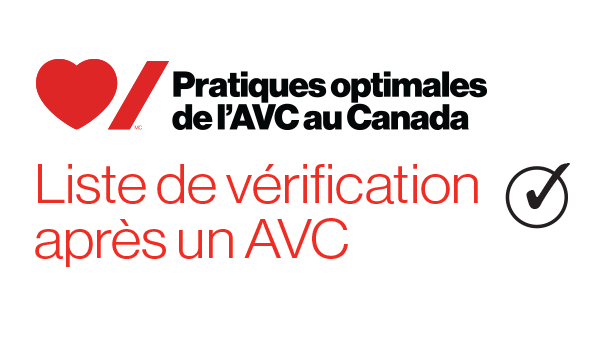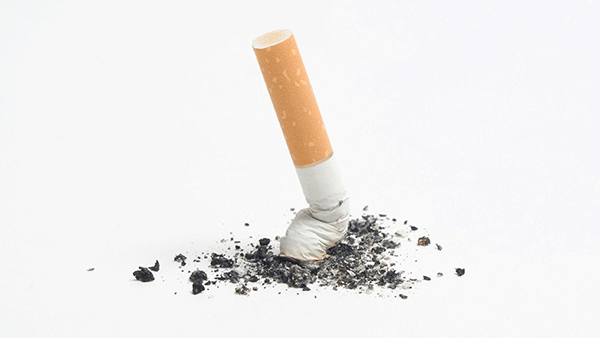Définitions et descriptions
Fatigue après un AVC : La fatigue après un AVC est une expérience émotionnelle, cognitive, motrice, perceptuelle et multidimensionnelle consistant à ressentir rapidement de la fatigue, de la lassitude, une absence d’énergie et une aversion à l’effort qui se développent durant une activité physique ou mentale et qui ne disparaissent pas après une période de repos. La fatigue peut être objective ou subjective; la fatigue objective est définie comme la diminution observable et mesurable de la performance qui survient lors de la répétition d’une tâche physique ou mentale, alors que la fatigue subjective consiste à ressentir rapidement de la fatigue, de la lassitude et une aversion à l’effort (Acciarresi et coll., 2014; Staub, 2001; Annoni, 2008; Lerdal, 2009; Eskes, 2011).
Les caractéristiques de la fatigue après un AVC comprennent notamment une fatigue et une absence d’énergie disproportionnées pour exécuter les tâches de la vie quotidienne; un besoin anormal de siestes ou de périodes de repos, ou de sommeil prolongé; le fait d’être plus facilement fatigué par des activités qu’avant l’AVC; une fatigue non prévisible ressentie sans raison apparente.
3.0 Fatigue après un AVC
La fatigue après un AVC est un problème courant qui peut survenir après un AVC à n’importe quel moment du processus de rétablissement. La fatigue après un AVC passe souvent inaperçue. Par conséquent, les professionnels de la santé doivent prévoir la possibilité de fatigue après un AVC, et préparer les personnes qui ont subi un AVC et leur famille à atténuer la fatigue en évaluant, éduquant et intervenant à n’importe quel moment dans le continuum de rétablissement après un AVC [niveau de preuve B].
Remarque : La fatigue après un AVC ne semble pas corrélée avec la sévérité de l’AVC. Les personnes qui ont subi un AVC très mineur peuvent tout de même ressentir de la fatigue.
3.1 Dépistage et évaluation
- Avant d’accorder un congé du service de soins aigus ou de la réadaptation en milieu hospitalier, il faut fournir à la personne qui a subi un AVC, à sa famille et aux aidants des renseignements de base sur l’éventualité de la fatigue après un AVC [niveau de preuve C].
- Après le retour dans la communauté, les personnes qui ont subi un AVC doivent être soumises régulièrement à un dépistage de la fatigue après un AVC durant les consultations médicales de suivi (p. ex., soins primaires, soins à domicile, cliniques de prévention extrahospitalières ou de réadaptation) [niveau de preuve C]. Veuillez consulter le tableau 3A à l’annexe 2 pour un résumé des outils de dépistage proposés. (hyperlink not available yet)
- Les personnes qui éprouvent de la fatigue après l’AVC doivent être soumises à un dépistage de comorbidités communes après un AVC et traitables, et de médicaments qui sont associés à la fatigue et/ou l’aggravent, y compris [niveau de preuve B] :
- signes de dépression ou d’autres problèmes associés à l’humeur; troubles du sommeil ou facteurs qui réduisent la qualité du sommeil (p. ex., apnée du sommeil, douleur); autres problèmes médicaux courants après un AVC, et médicaments qui augmentent la fatigue (p. ex., pour une infection systémique telle que l’infection des voies urinaires, la déshydratation, les médicaments à effet sédatif et l’hypothyroïdie).
3.2 Gestion de la fatigue après un AVC
- Les personnes ayant subi un AVC doivent recevoir des soins prodigués par des professionnels de la santé habilités à reconnaître les symptômes de fatigue et leur prise en charge [niveau de preuve C].
- Des données probantes limitées suggèrent que le traitement pharmacologique de la fatigue après un AVC avec du modafinil peut être envisagé chez certaines personnes qui ont subi un AVC [niveau de preuve C]. D’autres recherches sont nécessaires afin de comprendre pleinement les avantages de ce traitement.
- Il n’y a pas pour le moment suffisamment de données probantes qui permettraient de formuler une recommandation précise d’antidépresseurs pour la fatigue après un AVC [niveau de preuve B].
- La psychothérapie (thérapie cognitivo-comportementale) peut être envisagée comme traitement complémentaire de la fatigue après un AVC [niveau de preuve B].
- La réduction du stress par la pleine conscience peut être envisagée comme traitement complémentaire de la fatigue après un AVC [niveau de preuve B].
- Il est recommandé d’obtenir des conseils sur des exercices réguliers progressifs comportant des exigences physiques croissantes appropriées au niveau de tolérance, afin de prévenir le déconditionnement et d’améliorer la tolérance physique [niveau de preuve C].
- Il est recommandé d’obtenir des conseils sur des stratégies de conservation de l’énergie visant à optimiser la fonction quotidienne dans les activités prioritaires (p. ex., les routines quotidiennes et les tâches modifiées qui prévoient des besoins énergétiques et offrent un équilibre activité/repos) [niveau de preuve C]. Veuillez consulter la case 3 pour obtenir des exemples de stratégies de conservation de l’énergie.
- Il est recommandé d’obtenir des conseils sur des comportements favorisant une bonne hygiène du sommeil [niveau de preuve B].
- L’éducation nécessaire doit être offerte aux personnes qui ont subi un AVC, à leur famille et aux aidants en ce qui concerne la gestion du temps et la planification d’un équilibre d’activités et de périodes de repos [niveau de preuve C].
- Les personnes qui ont subi un AVC et qui ressentent de la fatigue doivent communiquer leurs besoins en état énergétique et repos aux professionnels de la santé, aux membres de la famille, aux aidants, aux employeurs et aux groupes sociaux [niveau de preuve C].
La fatigue post-AVC est généralement sous-diagnostiquée et elle n’est pas évaluée d’une manière systématique chez les personnes qui ont subi un AVC. Pourtant, les personnes qui ont subi un AVC en phase aiguë et en phase chronique d’un rétablissement post-AVC signalent souvent des symptômes de fatigue. Les taux de prévalence de la fatigue post-AVC sont assez élevés, et varient de 38 à 73 %. De plus, ces taux n’ont pas tendance à baisser d’une manière considérable après la phase post-aiguë, même après plusieurs années post-AVC. Cette fatigue est observée chez tous les types de personnes qui ont subi un AVC et ne dépend pas de la taille, de la localisation ou de la sévérité de l’accident. Elle est souvent associée à une humeur dépressive et à des troubles du sommeil, mais elle s’observe aussi en leur absence. Les données montrent qu’elle a un effet négatif sur la capacité de la personne de participer activement à la réadaptation, ce qui se traduit par de moins bons résultats à long terme. Des recommandations ont donc été ajoutées aux Recommandations afin de faire mieux connaître la fréquence de la fatigue post-AVC, son effet physique et psychologique sur les personnes qui ont subi un AVC et l’effet négatif sur le rétablissement et sur les résultats.
- Protocoles visant l’inclusion de la fatigue post-AVC dans le dépistage et l’évaluation à tous les points de transition et étapes de soins après un AVC.
- Ressources et mécanismes pour la planification et la mise en œuvre des services en milieu extrahospitalier qui tiennent compte des besoins du patient, de la famille et des aidants et qui mettent l’accent sur la conservation de l’énergie (p. ex., accès à des aides de locomotion, à des services de transport, à des conseils).
- Modèles de soins comprenant des technologies comme la télémédecine, le suivi téléphonique et le soutien par le Web afin de réduire le nombre de rendez-vous médicaux qui représentent une dépense d’énergie.
- Éducation et sensibilisation accrue à la fatigue après un AVC, et aux stratégies de gestion pour les personnes qui ont subi un AVC, les aidants, les employeurs et les professionnels de la santé.
- Nombre et proportion de personnes qui ont subi un AVC signalant des symptômes de fatigue post-AVC, calculés à chaque point de transition par rapport au nombre total de cas d’AVC.
- Proportion de personnes ayant subi un AVC qui retournent au service des urgences ou sont admises à nouveau à l’hôpital pour une incapacité de s’adapter ou une autre raison liée à la fatigue.
Notes sur la mesure des indicateurs
- Aucune mesure normalisée et validée de la fatigue post-AVC n’a été publiée pour cette population. Certaines échelles validées de la fatigue en tant qu’état pathologique s’appliquent et constituent un choix raisonnable pour le moment.
Renseignements sur les fournisseurs de soins de santé
- Table 3A: Summary Table of Post- Stroke Fatigue.
- Inventaire multidimensionnel (en anglais)
- Échelle de la sévérité de la fatigue (en anglais)
- Info AVC, fatigue
Information relative au patient
Post-Stroke Fatigue Evidence Tables and Reference List
Post-stroke fatigue (PSF) is known to occur commonly, is associated with mood disorders and pain, and negatively impacts recovery. Persons experiencing PSF report common experiences including having less capacity and energy, an abnormal tiredness and an overwhelming need for long-lasting sleep, being easily fatigued, fatigue for which there was no obvious cause or explanation and increased stress sensitivity (Eilertsen et al. 2013).
The incidence of PSF is difficult to estimate given that many patients report symptoms of pre-stroke fatigue (Lerdal et al. 2011). Estimates of incidence/prevalence also vary depending on when fatigue is assessed in the recovery process and which tool is used for assessment. At the time of admission to inpatient rehabilitation, fatigue was present in 51.5% of patients (Schepers et al. (2006) and at the point of discharge, in 58.3% of patients (Van Eijsden et al. 2012). Schepers et al. (2006) reported that fatigue was present in 64.1% and 69.5%, respectively at six months and one year. Overall, fatigue was present in 37.7% of patients and absent in 17.4%, at all assessment points. Of the patients reporting fatigue at one year, 29.3% were also depressed. Van der Port et al. (2007) reported that the percentages of patients considered fatigued at six, 12 and 36 months were 68%, 74% and 58%, respectively, in 223 acute stroke patients followed prospectively. In all these studies, the presence of fatigue was identified based on a score of ≥4 on the Fatigue Severity Scale. Parks et al. (2012) reported that of 228 participants who were surveyed 12 months post stroke, 37% reported symptoms of fatigue at least once during the previous month. Among those reported fatigue, 59.5% stated that fatigue was one of the worst or the worst symptom they experienced. Two years following stroke, of 5,189 patients who were alive and included in the Riks-Stroke national stroke registry, and who responded to a postal survey, 10% and 29.2% of respondents reported “always” or “often” being tired (Glader et al. 2002). In perhaps the largest systematic review of its kind, Cumming et al. (2016) included the results of 49 studies and estimated the prevalence of PSF at any point following stroke. Using the results from 22 studies that used the Fatigue Severity Scale and a cut-off level of ≥4 or >4, the prevalence of post-stroke fatigue was 50%, 95% CI 43–57%.
The clinical course of PSF is unclear; therefore, it’s even unknown if PSF increases or decreases over time. Snaphaan et al. (2011) reported that the prevalence of fatigue was 35% at two months post-stroke and 33% at 18 months. 26% of patients reported fatigue at both assessment points, while 9% reported fatigue at baseline but not at follow-up, and 8% reported no fatigue at baseline but did at follow-up. In a systematic review (Duncan et al. 2012), which included the results of nine studies, the percentage of patients reporting fatigue increased from assessment time one to time two in seven studies, while it had decreased between assessment points in two studies. In contrast, Cumming et al. (2016) reported the estimates of fatigue were relatively stable across time (within three months of stroke 55%, 95% CI 25–85%; one to six months 46%, 95% CI 31–62%; and greater than six months 53%, 95% CI 48–58%). Independent predictors of fatigue that have been identified include depression, low levels of physical functioning, and pre-stroke fatigue (Lerdal et al. 2011). Both increasing (Snaphaan et al. 2011) and decreasing age (Parks et al. 2012), have been reported as predictors of PSF, as have female (Schepers et al. 2006) and male sex (Gladder et al. 2002).
A few controlled studies have been conducted comparing fatigue in persons recovering from stroke with persons from the general population and in cases of transient ischemic attack. When compared with 1,069 persons of similar ages selected from the general population, the fatigue scores of 165 patients with acute stroke were significantly higher after adjusting for age, sex and living arrangements. Of the five subscale components of the Multidimensional Fatigue Inventory (MFI-20), stroke patients had significantly higher general and physical fatigue scores and also higher reduced activity scores at three months (Christensen et al. 2008). Winward et al. (2009) compared 73 subjects with minor stroke and 76 subjects with transient ischemic attack who were participants in the Oxford Vascular study. At six months, a higher proportion of participants with stroke reported significant fatigue, assessed using the Chalder Fatigue Scale (56% vs. 29%, p=0.008). A higher proportion of subjects with stroke, who had initial NIHSS scores of 0 reported significant fatigue compared with transient ischemic attack with initial NIHSS scores of 0 (57% vs. 29%, p=0.015). Subjects who felt they had not made a full recovery were more likely to be fatigued compared to those who felt they had (72% vs. 23%, p<0.0001).
There are few treatments for post-stroke fatigue that have been evaluated. A Cochrane review (Wu et al. 2015) included the results from 12 RCTs, four evaluating four pharmacological and four evaluating non-pharmacological approaches. In the remaining four trials, PSF was not the primary target of investigation, but fatigue was reported as an outcome. Using the results from seven trials (five pharmacological, two no-pharmacological), treatment was associated with a significant reduction in fatigue scores (WMD= -1.07, 95% CI -1.93, -0.21, p=0.014).
Pharmacological agents that have been evaluated in the treatment of PSF include selective serotonin reuptake inhibitors (fluoxetine) and modafinil. In the Modafinil in Debilitating Fatigue After Stroke (MIDAS) trial, 36 participants with PSF received 200 mg modafinil or placebo for six weeks (Bivard et al. 2017). Active treatment was associated with a significantly greater decrease in mean total Multidimensional Fatigue Inventory (MFI)-20 scores (MD= −7.38, 95% CI −21.76 to −2.99; P<0.001), mean FSS scores (MD= -6.31, 95% CI -10.7 to -1.9, p=0.048) and a significantly greater increase in total mean Stroke-Specific Quality of Life scores (MD=11.8, 95% CI 2.3 to 21.3, p=0.015). Poulsen et al. (2015) randomized 41 persons with PSF to receive 400 mg modafinil for 90 days. The results were ambiguous. At 90 days, there was no significant difference between groups in the median MFI-20 GF score (11 modafinil vs placebo 14, p=0.32), or in the median score of other MFI domains (physical fatigue, reduced activity, reduced motivation); however, median FSS and FSS-7 were significantly lower at 90 days for patients in the modafinil group (36 vs. 49.5, p=0.02 and 22 vs. 37.5, p=0.042). Fluoxetine was examined in a trial including 83 participants with post-stroke emotional disturbances, an average of 14 months after stroke onset, were randomized to receive 20 mg/day of fluoxetine (n=40) or placebo, (n=43) for three months (Choi-Kwon et al. 2007). At the end of treatment, there were no significant differences in the number of patients with PSF. At six months, 34 patients (85%) in the fluoxetine group reported PSF compared with 40 (93%) in the control group. However, at three months, fewer patients in the fluoxetine group reported excessive/inappropriate crying (n=16, 40% vs. n=27, 62.8%, p=0.038), and at six months fewer patients in the fluoxetine group were identified with depression (n=5, 12.5% vs. n=13, 30.2%, p=0.05).
Among trials evaluating non-pharmacological treatments for PSF, two reported significant improvements in symptoms. Zedlitz et al. (2013) randomized 83 participants with severe fatigue >4 months post stroke to participate in a 12-week program consisting of group cognitive treatment (control condition) or group cognitive treatment combined with graded activity training (COGRAT). Cognitive treatment consisted of cognitive behavioural therapy and compensatory strategy teaching. Those in the COGRAT group also received 24 sessions, each two hours in duration of graded activity training, including treadmill walking, strength training, and homework assignments. Participants who received COGRAT were significantly more likely to experience clinically relevant improvement in fatigue severity (57.9% vs. 24.4%, p=0.002). Johansson et al. (2012) randomized 29 patients, of whom 18 were recovering from stroke (11 from traumatic brain injury) with mental fatigue to participate in an eight-week program of Mindfulness–Based Stress Reduction (MBSR), which included yoga, body scan, and sitting meditation, or to a wait list control group. Compared with those in the wait list control group, participants who received the MBSR program immediately reported a significantly greater decrease in Mental Fatigue Scale scores. Non-pharmacological interventions that have been evaluated for the treatment of PSF and found not to be effective include the use of continuous positive airway pressure (Brown et al. 2011), a fatigue management education program (Clarke et al. 2012) and a six-month chronic disease self-management program (Lorig et al. 2001).






